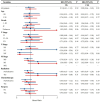Survival profiles and associated factors for overall and cancer specific survival in patients with chondroblast and fibroblastic osteosarcoma
- PMID: 40624293
- PMCID: PMC12234990
- DOI: 10.1038/s41598-025-10433-z
Survival profiles and associated factors for overall and cancer specific survival in patients with chondroblast and fibroblastic osteosarcoma
Abstract
We aimed to compare overall survival (OS) and cancer-specific survival (CSS) between patients with chondroblastic osteosarcoma and fibroblastic osteosarcoma, and to identify prognostic risk factors for these subtypes. Clinical and demographic data from 723 patients with either chondroblastic osteosarcoma or fibroblastic osteosarcoma were extracted from the SEER database. Cox proportional hazards models were used to assess the association of these two types of osteosarcoma with OS, while Fine-Gray competing risk models evaluated CSS, with adjustments for covariates in both unweighted and inverse probability treatment-weighted (IPTW) samples. Subsequent univariate and multivariate analyses identified prognostic factors specific to each subtype. We did not observe any statistically significant differences in terms of the association of the two pathological types of osteosarcomas with OS and CSS using either unweighted or weighted samples. For chondroblastic osteosarcoma, OS was significantly associated with age ≥ 30 years, non-Hispanic Black race, first cancer, primary site, T2-4 stage, M1 stage, and having chemotherapy and surgery were significantly associated with the OS. CSS was associated with age ≥ 30 years, T2-4 stage, M1 stage, and having surgery were associated factors for CSS. In patients with fibroblastic osteosarcoma, OS was significantly associated with primary site, M1 stage, and having radiation and surgery. While CSS was associated with primary site, T2-T4 and TX stage, N1 and M1 stage, and having radiation and surgery. The present study demonstrated the survival profiles of patients with chondroblastic and fibroblastic osteosarcoma. Patients with fibroblastic osteosarcoma do not have better OS or CSS compared with those with chondroblastic osteosarcoma. Multiple risk factors for a poor prognosis were identified, and they can be used to refine the therapeutic approach.
Keywords: Chondroblast osteosarcoma; Fibroblastic osteosarcoma; Risk factors; Survival analysis; Survival outcomes.
© 2025. The Author(s).
Conflict of interest statement
Declarations. Competing interests: The authors declare no competing interests. Ethics approval: We received acceptance of the data access agreement from the SEER administration. No Institutional Review Board approval was required for this study, since no personal-identifying information is included in our dataset.
Figures


Similar articles
-
Do Patients of Different Levels of Affluence Receive Different Care for Pediatric Osteosarcomas? One Institution's Experience.Clin Orthop Relat Res. 2025 Apr 1;483(4):748-758. doi: 10.1097/CORR.0000000000003299. Epub 2024 Oct 30. Clin Orthop Relat Res. 2025. PMID: 39485923
-
Comparison of Two Modern Survival Prediction Tools, SORG-MLA and METSSS, in Patients With Symptomatic Long-bone Metastases Who Underwent Local Treatment With Surgery Followed by Radiotherapy and With Radiotherapy Alone.Clin Orthop Relat Res. 2024 Dec 1;482(12):2193-2208. doi: 10.1097/CORR.0000000000003185. Epub 2024 Jul 23. Clin Orthop Relat Res. 2024. PMID: 39051924
-
Competing risk and random survival forest models for predicting survival in post-resection elderly stage I-III colorectal cancer patients.Sci Rep. 2025 Jul 7;15(1):24269. doi: 10.1038/s41598-025-05824-1. Sci Rep. 2025. PMID: 40624131 Free PMC article.
-
Optimisation of chemotherapy and radiotherapy for untreated Hodgkin lymphoma patients with respect to second malignant neoplasms, overall and progression-free survival: individual participant data analysis.Cochrane Database Syst Rev. 2017 Sep 13;9(9):CD008814. doi: 10.1002/14651858.CD008814.pub2. Cochrane Database Syst Rev. 2017. PMID: 28901021 Free PMC article.
-
Impact of residual disease as a prognostic factor for survival in women with advanced epithelial ovarian cancer after primary surgery.Cochrane Database Syst Rev. 2022 Sep 26;9(9):CD015048. doi: 10.1002/14651858.CD015048.pub2. Cochrane Database Syst Rev. 2022. PMID: 36161421 Free PMC article.
References
-
- Gill, J. & Gorlick, R. Advancing therapy for osteosarcoma. Nat. Rev. Clin. Oncol.18(10), 609–624 (2021). - PubMed
-
- Belayneh, R., Fourman, M. S., Bhogal, S. & Weiss, K. R. Update on Osteosarcoma. Curr. Oncol. Rep.23(6), 71 (2021). - PubMed
-
- Aran, V. et al. Osteosarcoma, chondrosarcoma and ewing sarcoma: Clinical aspects, biomarker discovery and liquid biopsy. Crit. Rev. Oncol. Hematol.162, 103340 (2021). - PubMed
MeSH terms
Grants and funding
- 82372668/National Natural Science Foundation of China
- 82001312/National Science Foundation for Young Scientists of China
- CHZJU2022YS008/Special Fund for the Incubation of Young Clinical Scientist, Children's Hospital of Zhejiang University School of Medicine
- 2021CXA032/Medical Innovation Foundation of Fujian Province
LinkOut - more resources
Full Text Sources
Medical

